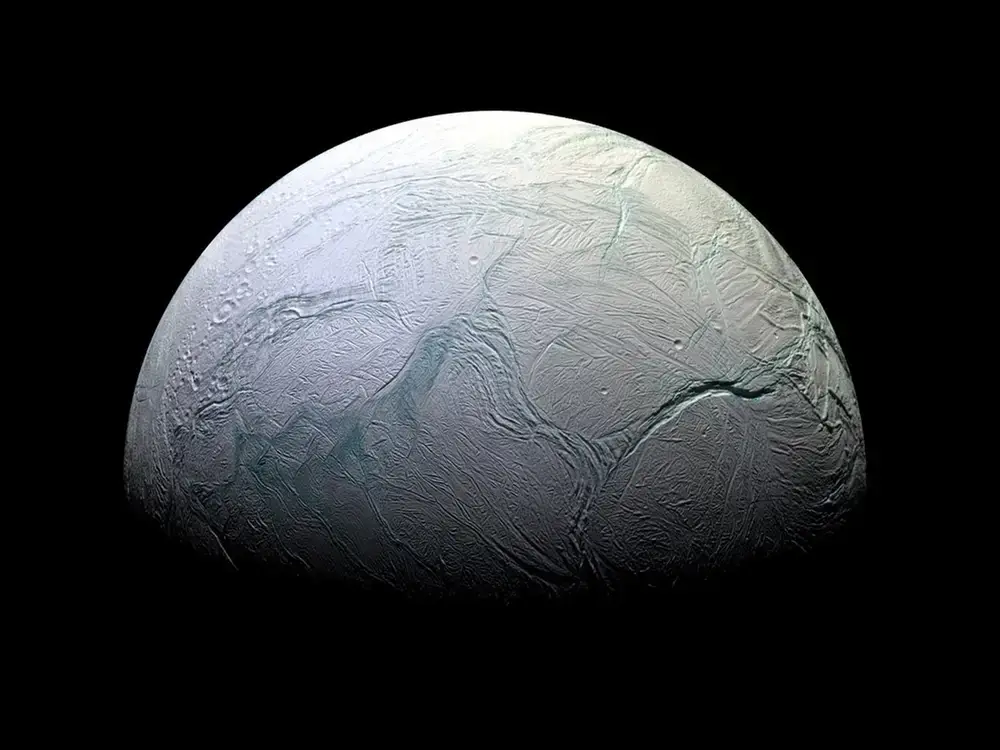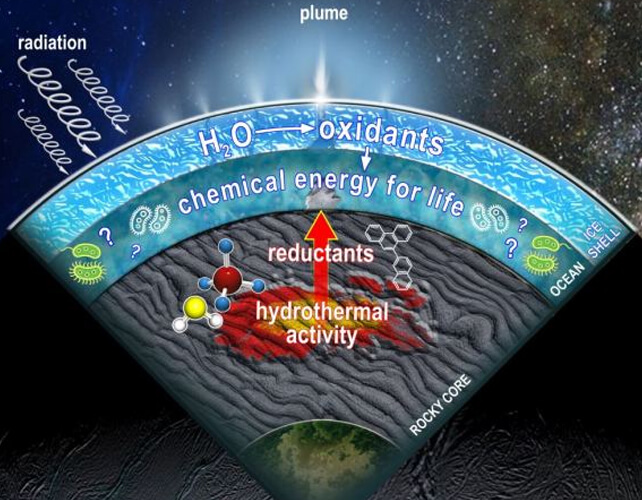
Saturn’s Ocean Moon Enceladus Has All The Building Blocks For Life, Research Shows
The discovery of phosphorous means it contains all the chemical building blocks for life.
By: Evan Gough | Universe Today
Saturn’s ocean moon, Enceladus, is attracting increasing attention in the search for life in our Solar System.
Most of what we know about Enceladus and its ice-covered ocean comes from the Cassini mission. Cassini ended its exploration of the Saturn system in 2017, but scientists are still working through its data.
New research based on Cassini data strengthens the idea that Enceladus has the chemicals necessary for life.
During its mission, Cassini discovered geyser-like plumes of water erupting through Enceladus’ icy shell. In 2008, Cassini performed a close-proximity flyby and analysed the plumes with its Cosmic Dust Analyser (CDA).

The CDA showed that the water in the plumes contained a surprising mix of volatiles, including carbon dioxide, water vapour, and carbon monoxide. It also found trace amounts of molecular nitrogen, simple hydrocarbons, and complex organic chemicals.
But Cassini’s data is still being analysed, even six years after it completed its mission and was sent to its destruction in Saturn’s atmosphere. A new paper titled “Observations of Elemental Composition of Enceladus Consistent with Generalized Models of Theoretical Ecosystems” presents some new findings. The lead author is Daniel Muratore, a post-doc at the Santa Fe Institute.
The work centres on the discovery of ammonia and inorganic phosphorous in Enceladus’ ocean. The researchers used ecological and metabolic theory and modelling to understand how these chemicals could make Enceladus amenable to life.
“Apart from speculating about threshold concentrations of bioactive compounds to support ecosystems, metabolic and ecological theory can provide a powerful interpretative lens to assess whether extraterrestrial environments are compatible with living ecosystems,” the authors explain.
A critical component of ecological theory is the Redfield ratio. It’s named after the American oceanographer Alfred Redfield. In 1934, Redfield published results showing that the ratio of carbon to nitrogen to phosphorous (C:N:P) was remarkably consistent across ocean biomass at 106:16:1. Other researchers found that the ratio shifted slightly depending on the area and the phytoplankton species present. More recent work refined the ratio to 166:22:1.
The exact numbers aren’t necessarily the critical point. Redfield’s conclusion is the vital part. The Redfield ratio shows a remarkable unity between the chemistry of living things in the deep ocean and the ocean itself. He proposed that there’s an equilibrium between ocean water and plankton nutrients that’s based on biotic feedback. He described a chemical framework for nutrients and simple life.
“Whatever its explanation, the correspondence between the quantities of biologically available nitrogen and phosphorus in the sea and the proportions in which they are utilized by the plankton is a phenomenon of the greatest interest,” Redfield said in the conclusion of his paper.
So, how does the discovery of ammonia and phosphorous in Enceladus’ ocean relate to the Redfield ratio and Enceladus’ biological potential?

The Redfield ratio is widespread all across the Tree of Life on Earth. “Because of this seeming ubiquity, the Redfield ratio has been considered a target signature for astrobiological life detection, especially on ocean worlds such as Europa and Enceladus,” the authors of the new paper write.
When it comes to life, all we have to go on is Earth. So it’s sensible to use foundational aspects of life’s chemistry here on Earth as a lens through which to examine other potential life-supporting worlds.
Analysis of Cassini’s data from Enceladus’ plumes shows a high level of inorganic phosphate in the ocean. Other geochemical simulations based on Cassini’s findings indicate the same.
“These reports of phosphorus follow on the tails of previous work identifying numerous elemental constituents of terrestrial life (C, N, H, O) from the Enceladus plume,” the authors explain.
Even more analysis suggests that the ocean contains many of the chemicals common in living organisms, like amino acid precursors, ammonium, and hydrocarbons.
So Enceladus’ ocean has a rich chemistry, and many chemicals reflect life’s chemical makeup. In particular, there’s an emerging hypothesis that Enceladus could support methanogenesis.
Earth’s Archaea perform methanogenesis across a wide swath of different environmental conditions on Earth and have done so for over three billion years, proving their survivability. Biochemical modelling suggests that Earth’s methanogens are compatible with Enceladus’ ocean.
The researchers developed a new, more detailed model for methanogens on Enceladus to see if they could survive and thrive there. Their model leaned heavily on the Redfield ratio. They found that though phosphorous is present in high levels in the moon’s ocean, the overall ratio “may be limiting to Earth-like cells.”
“High standing stocks of these nutrients could be consistent with incomplete drawdown due to a small or metabolically slow biosphere, a biosphere with a recent origin of life,” or other reasons that could cause an imbalance.
So where does that leave the prospects for life on Enceladus?
We’re only at the beginning of biosignature science. We can identify individual chemicals, but from this great distance away, we can’t accurately measure Enceladus’ overall chemistry. Newer biosignature research, including this paper, aims to identify how biological processes reorganize chemical elements in telltale ways. By looking at entire ecosystems, as Redfield did, scientists may discover new biosignatures that are less ambiguous.
If we can do that, we may discover that non-Earthly life-forms reorganize chemicals in entirely different ways.
This research is part of a new effort to detect more than individual chemical biosignatures, some of which can be false positives. Methane, for example, can be a biosignature but can also be produced abiotically. There are others, like the recently discovered phosphine on Venus.
Understanding ecosystems as a whole is the next step. There’s a bewildering number of factors to consider. Cell size, nutrient availability, radiation, salinity, temperature. On and on. But to understand the overall chemical environment at Enceladus, Europa, or anywhere else, we need more detailed data.
Luckily, instrument science keeps improving, and upcoming missions to Europa will start to paint a fuller picture. According to the authors, the next step requires more fulsome data and a more generalized approach.
“We suggest two priorities for further astrobiological research to better understand the implications of these conclusions,” they write. “First, we echo previous calls in the astrobiology literature to explore more generalized notions of metabolism and physiology.”
They also suggest that looking for direct parallels to terrestrial life in the form of biochemistry may not be the best strategy for looking for life on Enceladus.
“Second, we recommend broadening the scope of Earth analogue environments to include those with extreme resource supply ratios mirroring that suggested for Enceladus,” they explain.
Our understanding of habitability grows incrementally, as this study clearly shows. There’ll likely be no revelatory moments where we suddenly understand it.
Nature has created a vast variety of worlds, each with its own chemistry. While using tools like the Redfield ratio as a lens is one way of looking at these worlds in all their unique glory, we can’t get tunnel vision.
While most of what our imaginations dream up about life on other worlds is fanciful and unlikely, life could’ve found another way on Enceladus. There could be different ways that life exists in and reorganizes chemical environments.
* * *
NEXT UP!
How Many Moons Does Saturn Have?
There’s a race happening in our solar system, but it has nothing to do with gravitational mechanics or velocity. Astronomers who study the gas giant planets of Saturn and Jupiter are in a close competition to see who can discover more moons — and it’s anybody’s game.
At this point, ringed Saturn has the most moons of any planet in the solar system, but exactly how many moons does Saturn have? And how does that compare to massive Jupiter’s count?
* * *
READ MORE: Ex-SpaceX Engineers Bring Mars Colony Tech To Earth
Read more on Space News: This Is What The James Webb Telescope Saw On Titan
Liked it? Take a second to support Collective Spark.
We’d love to hear from you! If you have a comment about this article or if you have a tip for a future Collective Spark Story please let us know below in the comment section.
